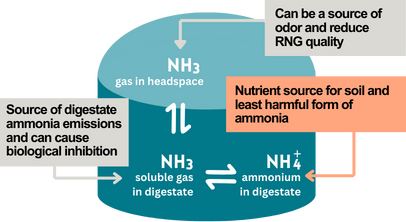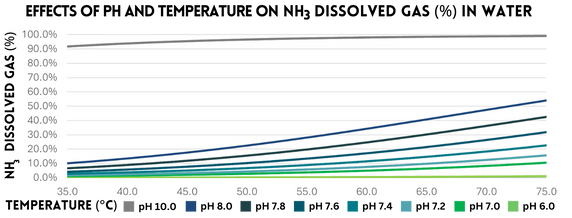Too much ammonia? Here’s what you can do today!

If lab testing indicates that your digestate might contain too much ammonia, what can you do?
- NH3 gas levels can be quickly reduced by cooling, adding acidic feedstocks, reducing HRT to reduce protein conversion.
- For improved stability, digesters can be operated at lower temperatures and mid-range pH levels.
Temperature and pH determine ammonia’s dominant form in a digester. Higher temperature and higher pH shift the equilibrium towards the problematic gaseous NH3 form.
The graph below plots the percent of dissolved “total” ammonia (NH3aq + NH4+) in digestate that is in the inhibitory NH3 form at different pHs and temperatures. The rest of the “total ammonia” is in the least harmful, ionized (NH4+), form. The equilibrium is more sensitive to pH.
The fraction of inhibitory NH3 can increase more than 10X over a small change in pH and temperature!
Contact Azura for more detailed solutions to your ammonia challenges.

This article first appeared in the 2024 BiogasWorld Showcase report. To view the full report visit the BiogasWorld website.
Related Articles
Top 10 Things to Make Your Digester Biology Happy
Anaerobic digestion is a complex biological process that requires a great deal of nuance and subtlety to optimize its operation. This article looks at the 10 most critical aspects of AD and how to make them run for the best outcome. Read the full article.
Commonly Overlooked Reasons for Anaerobic Digester Failures
Based on more than 30 years experience with digester facilities, this article presents the top five commonly overlooked causes of digester failure so you can recognize and avoid these pitfalls. Read the full article.
Get Insights from the Bioprocess Experts Right to Your inbox
Sign up to the Discover Digesters Newsletter to access Azura’s best practices, field-tested advice, and insights into the anaerobic digestion & industrial wastewater treatment industries.
By submitting this form, you are consenting to receive marketing emails from: Azura Associates. You can revoke your consent to receive emails at any time by using the SafeUnsubscribe® link, found at the bottom of every email. Emails are serviced by Constant Contact.
